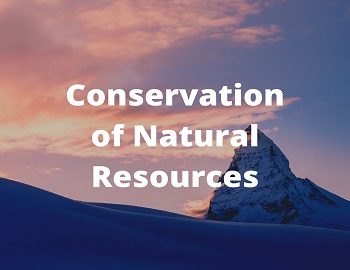Table of Contents
Conservation of Natural Resources:
The natural resources are of two kinds- Renewable and Non-renewable. Renewable natural resources reproduced and, thus, restore themselves in a natural way (example- when trees are cut, they can grow again; soil forms again; animals reproduce their kind). They include soil, water, vegetation (forests and other plants), wildlife and air. Non-renewable natural resources do not reproduce themselves in a natural way but are exhausted forever when once they are used up. They include minerals, coal and oil. Though the natural resources can be restored they too may be lost if misused. It is, therefore, essential for a man to conserve the natural resources so that the human population may not face a dark future due to their shortage or non-availability. Conservation of natural resources does not mean their preservation without using them but it suggests that we should use the natural resources wisely and economically, without wasting them.
Let us consider the conservation of natural resources like soil, water, forests, wildlife and non-renewable resources, in some detail.
Conservation of Soil:
Conservation of soil can be achieved by preventing soil erosion and preserving soil fertility.
Preventing Soil Erosion:
Removal of the top fertile soil by any agency like wind or water is known as soil erosion. The main causes of soil erosion are-
- Absence of vegetation covering.
- Improper tillage.
- Leaving agricultural fields fallow i.e. ploughed but unsown, for a long time.
- Expansion of urban areas.
We can prevent the soil erosion by wind by planting trees and grass excessively. Moreover, fields should not be kept fallow for a long time. Erosion of soil by water can be prevented by having proper irrigation, drainage and binding in the fields, intensive cropping and terracing of sloping lands (i.e. growing plants in layers round the hill so that water cannot drain away down the slope and carry the fertile top soil with it).
Preserving Soil Fertility:
The fertility of soil can be preserved in the following ways-
- By not keeping the fields uncultivated for a long time. In this way, the soil is not exposed to the onslaught of wind which can cause soil erosion and loss of fertility.
- By rotation of Crops. A particular type of crop grown again and again in the same field makes the soil devoid of nutrients which that crop requires. Now leguminous plants such as pulses, peas and beans contain nitrogen-fixing bacteria in their root nodules. These bacteria fix up atmospheric nitrogen and make the soil fertile. If the main crops and the leguminous plants are not grown in the fields year after year but rotated (example- pulse crop grown between two cereal crops), then all nutrients in the soil remain in balance and, thus, the soil fertility is preserved.
- By using fertilizers. Soil is said to be a complex mixture of physical, chemical and biological materials. These materials must remain in the soil in suitable quantities. For this purpose, it is essential to use fertilizers which can replenish the soil.
Conservation of Water:
Conservation of water is essential for the maintenance of life on earth. There are two main techniques for conserving water. These are maintaining water cycle and preventing pollution.
Maintaining Water Cycle:
This requires preservation and afforestation of hill slopes and catchment areas (which hold rainwater), construction of dams near catchment areas and digging of ponds. Moreover, we must guard lakes, ponds, marshes and swamps so that such wetland areas are not filled with mud and reclaimed as land.
Preventing Pollution:
Conservation of water by preventing its pollution can be achieved by taking following precautions-
- Industries should not dump their industrial waste directly into the nearest river or lake.
- Ships and oil tankers should not dump their oil into the oceans.
- Sewage of cities and towns should not be released to rivers or lakes directly but it should be first processed through special sewage plants so that only water is released into the river or lake.
- Water should not be pumped out of the soil for its use in industries. In case this precaution is not taken then the water after use, if possible, should be poured back in the soil.
Conservation of Forests:
Conservation of forests is the necessity of time when the natural resources are being exhausted and the pollution is increasing all around. Various factors are responsible for this man-made problem. For instance, trees are cut for making timber and lot of wood is wasted in the process, farmers adopt the method of shifting cultivation in which they clear an area of forest for agricultural use but abandon the land when the soil is exhausted and then clear another piece of forest for the same purpose, sometimes forests are destroyed for clearing the areas to set up industries and factories.
Conservation of forests involves economical use of forest wood, prevention of forest fires, use of better farming methods and, thus, avoiding shifting cultivation, control of plant pests and diseases, and reafforestation of land.
Conservation of Wildlife:
Man destroys wildlife by hunting for the sake of mere sport or financial gains. By doing this, he is disturbing various food chains and, thus, creating imbalance in nature.
Conservation of wildlife requires the fulfilment of the following conditions-
- Preservation of different habitats (tropical forests, pine forests, wetlands, grasslands, etc.) in which the animal live.
- Permission of hunting to licensed persons only.
- Prevention of killing or catching young animals.
- Prohibition of killing those animals which are rare or facing extinction.
- Prohibition on shooting more than a specified number of each type of animals per day.
- Establishment of wild-life sanctuaries and national parks on a possible large scale.
Non-renewable Natural Resources:
Technology-based culture of these days is encouraging the excessive use of non-renewable natural resources such as coal, oil and minerals. If this trend is not checked properly, these resources will soon be exhausted and, in that case, the human population will face a lot of troubles example- energy crisis. To meet this challenge, we must use the non-renewable natural resources as sparingly as possible and also make honest efforts to harness and use other sources of power that will not be exhausted. These sources include solar energy, wind force and water power.
- Soil Erosion & Soil Conservation Measures
- Desertification- Effects & Remedies
- Renewable and Non-Renewable Energy Sources
- Constituents Of Air And Their Uses
- Air Pollution- Causes, Effects, and Control Measures
- Water Pollution- Causes, Effects, and Control Measures
- Solid Waste Management
- Principles of Ecology









Comments (No)